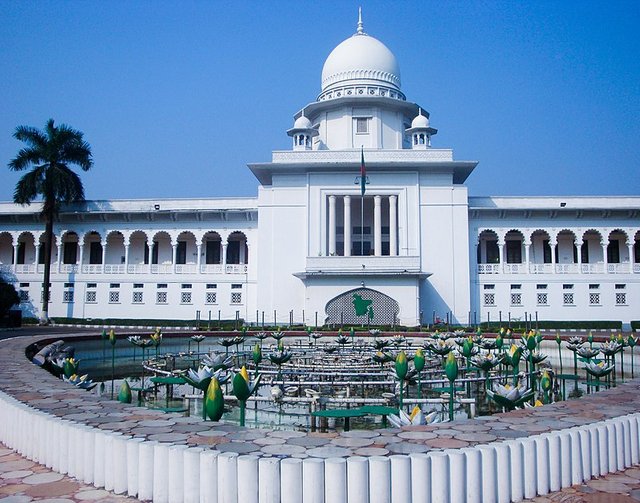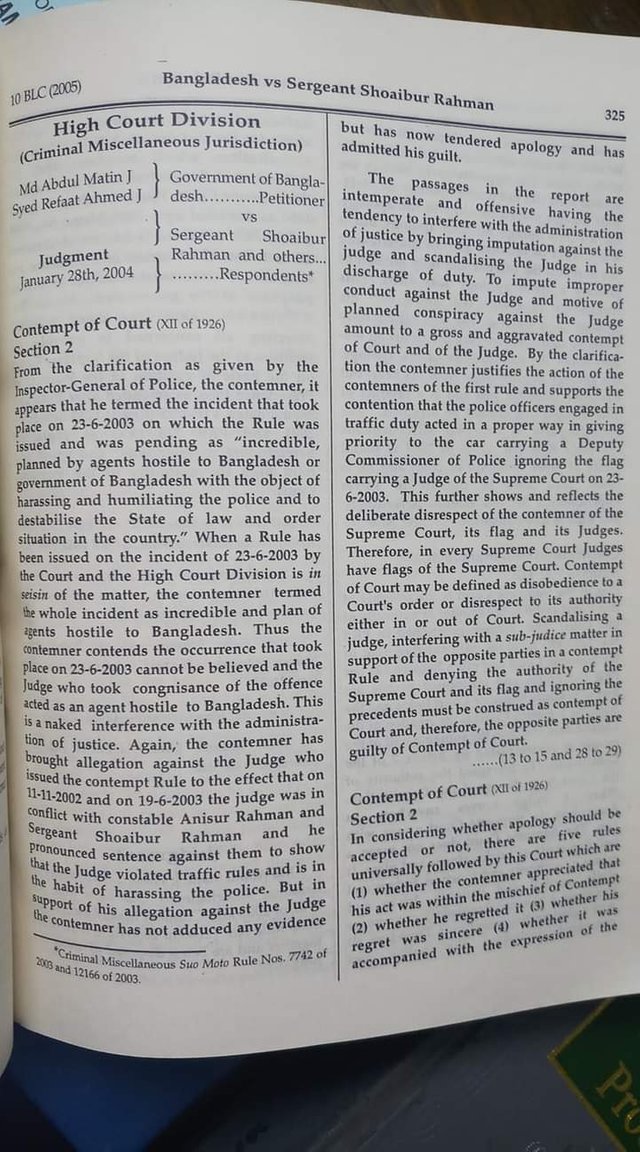Assalamu-Alaikum
How are you all? I hope everyone is well by the grace of God. Today I will share with you an incident that happened between a police officer and a judge. I hope everyone will read. Let's get started.
The Story of the Arrogance of the Powerful Police Chief and the Application of the Justice of the Peace and the Dignity of the Judiciary.
Hon'ble Justice of Bangladesh Supreme Court Mr. Shamsuddin Chowdhury Manik was crossing Banani Kamal Ataturk area in a government vehicle on 19-06-2003.

At that time, the police sergeant stopped the car of the judge and arranged for a blue police jeep to go ahead.
At the same time he saluted the police car. Noticing the matter, the Justice got out of the car and asked the sergeant, "Why don't you salute the car with the logo of the Supreme Court?"
"We are not obliged to salute the flag of the Supreme Court," the sergeant said. I didn't stop there!
Sergeant Soyebur Rahman got into an argument with Justice over the matter. Soebur Rahman later called some other police sergeants in the vicinity.
Five police officers insulted the judiciary in various ways.
Hon'ble Justice Mr. Shamsuddin Chowdhury Manik on 30 June 2003 directed five police officers to appear in court in person.
At the same time, IGP and Principal Police Training College were directed to answer the following questions by 12 July 2003 .........
( 1)Does the derogatory expression of sergeant shoaib, echo what the members of police forces are given to understand their training?
(2)Are the police officials of all ranks trained to understand that every person in uniform is under indispensable legal obligation to show utmost respect to the Supreme court saluting the august body's flag?
(3) Are the police officials briefed on the warrant of precedence and trained to follow them at all events?
(4)Are they trained to learn that it is internecinely contumacious to the solemn grandeur of the Apex court to hold back a car with its flag in order to allow the passage of a vehicle which carries a person of lesser importance in the warrant of precedence?
Shortly after giving this instruction, the temporary judge Mr. Shamsuddin Chowdhury Manik was no longer in service as his job was not permanent.
Answering four questions, the police chief said that the police sergeant was not obliged to salute the judge while on duty. The judge who gave the order is no longer in service. The judge should be tried for obstructing government work and threatening police officers under the country's customary law.

At the same time, the IGP criticized the judiciary and the Supreme Court in various ways.
Following the copy of the reply, Justice Md. Abdul Matin and Justice Syed Rifat Ahmed voluntarily issued a contempt of court rule against the IGP. At the same time, he directed the IGP to appear in court in person.
The IGP appeared in person.
The High Court Division sentenced four police officers, including IGP Shahadul Haque, to various terms and fines for not being satisfied with their response.
*High Court Division observed that "His apology has come from his pen and is a product of after thought and cannot be accepted. The opposite party in criminal Miscellaneous suo moto Rule No. 12166 of 2003 is found guilty of gross contempt of court and he is fined Taka 2000 in default to suffer imprisonment for one month.
Following the order of the High Court Division, prominent lawyers of the country opined that under the Public Servant (Dismissal on Conviction) Ordinance 1985, there was no opportunity for Chief of Police Shahadul Haque to have a job.
The IGP was at an international conference at Interpol headquarters in France when the verdict was handed down.
He was not given protocol as police chief at the airport when he arrived in the country.
He was removed from his post and placed in charge of the DMP commissioner. He was later suspended.
The High Court Division in this judgment made some important observations about the status and position of the judiciary.
High court division observed that, In a welfare state in order to administer of justice lawfully, judicially and without fear on favour, certain protection is required for the court of law and the process engaged in the administration of Justice from insult, annoyance, obstruction and wilful disobedience in order to maintain its honour, dignity, prestige and authority and thus law of contempt is the indispensible protection as a legal concept has evolved though ages as protection against signifying disrespect to that which is entitled to legal regard.
High court division also observed that "No agencies of the state will be allowed to attack and defame the honour, prestige and Independence of judiciary of the Republic ”.
High court Division also observed that " the police is duty bound to obey and comply with any order including judicial orders of the Republic and is not permitted to question the order as to why and how "
In an immediate response to the verdict, constitutional expert M Zaheer said:
The high ups in the executives should now understand that the judiciary is determined to protect the rights of people. Those who show disrespect to the judiciary and the rule of law must be punished ".
His Excellency the High Court Division made it clear that according to Article 112 of the Constitution, the executive branch, including the police, is obliged to assist the court.
Moreover, court means not only the dome-shaped building, but the whole of Bangladesh under the jurisdiction of the Supreme Court judge under Article 25 of the Code of Criminal Procedure.
The whole of Bangladesh has the power to exercise jurisdiction.
Defendants, including the police chief, went to the Appellate Division against the verdict.
The Appellate Division dismissed the appeal as there was no reason to intervene in the judgment of the High Court.
Considering the necessity of the judiciary, when the Code of Criminal Procedure was formulated in 1896, the provisions related to Justice of Peace were discussed in sections 22-25. Sections 23 and 24 of the Criminal Law Amendment Act, 1923 were repealed in 1923. Section 25 provides for ex officio to act as Justice of the Peace.
Section 25 of the Code of Criminal Procedure, 1898 contains-
In virtue of their respective offices, the Judges of the Supreme Court are Justices of the Peace within and for of the whole of Bangladesh, Sessions Judges, Chief Judicial Magistrate and Metropolitan Magistrates are Justices of the Peace within their respective jurisdictions.
According to the provisions of this section, ex-officio judges of the Supreme Court can exercise their powers for the whole of Bangladesh as Sessions Judges, Chief Judicial Magistrates, Metropolitan Magistrates as Justices of Peace within their respective jurisdictions.
The Code of Criminal Procedure, 1898 mentions these provisions of the Justice of the Peace, but does not specify how the powers of the Justice of the Peace will be exercised. Pakistan has amended the CRPC to add two separate sections, 22-A and 22-B. Of these, Article 22A defines the powers of the Justice of the Peace.
As the powers and responsibilities of the Justice of the Peace are not defined in the Code of Criminal Procedure, there are very few instances of exercise of power in this regard in our country. The provisions of Sections 22 and 25 relating to Justice of Peace are in force in the Code of Criminal Procedure.
Therefore, it is necessary to determine the powers and responsibilities of the Justices of Peace, especially the wise District Sessions Judges and the wise Chief Judicial Magistrates so that they can properly maintain law and order and in special cases the image and dignity of the overall judiciary. In this case, it is necessary to amend the Code of Criminal Procedure on Justice of Peace.

The power of the Justice of the Peace is a kind of special power. Proper application of this provision is related to the dignity and honor of the judiciary. It is to be hoped that in spite of the lack of specific provisions, the exercise of the powers of Justice of the Peace in various districts, including the rice of relief during the Corona period, has created a positive attitude among the general public.
References
*Shahudul Haque, IGP, police and others Vs state, 35 CLC (AD) (1092)
*Government of Bangladesh Vs Sergeant Shoaibur Rahman and others 10 BLC 325.
*Miscellaneous Suo Moto Rule No. 12166 of 2003 (HCD)
And
*The Daily Star Newspaper.
©Source